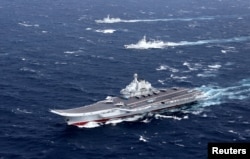China has launched its first domestically built aircraft carrier, marking an important military milestone. The vessel will become the second carrier in the country’s expanding naval fleet.
Analysts say the launch highlights the strides China has made in advancing its carrier program, as well as its ambitions to project power further into the Pacific and Indian Ocean.
Fan Changlong, vice chairman of China’s Central Military Commission, presided over a ceremony for the launch of the Shandong on Wednesday in the northeastern port of Dalian. A champagne bottle was cracked over the bow during the event and state television showed tugboats, pushing the vessel away from its berth.
Step by step
State media say the aircraft carrier has its propulsion, power and other main systems in place, but will not enter into service until 2020.
“The launch of the aircraft carrier is a significant achievement and shows our country's indigenous aircraft carrier design and construction has achieved major step by step results," a state broadcaster announced, shortly after the ceremony.
China’s first aircraft carrier, the Liaoning, went through a similar process where it had to run a series of sea trials and be fitted with weapons systems before entering full service.
That aircraft carrier was a rebuilt second hand Soviet vessel called the Varyag that was purchased from Ukraine. Following its sea trials in 2011, the Liaoning has taken part in patrols in the South China Sea.
The new carrier is so strikingly similar to the Liaoning aircraft carrier that many are calling it the Liaoning upgrade.
The new carrier is slightly bigger and Chinese military officials say it has significant improvements that will raise its fighting and training capabilities. One key addition that has been highlighted is additional hangar space for fighter jets.
Watershed moment
Alex Neill, a senior fellow for Asia-Pacific security at the International Institute for Strategic Studies called the launch a “watershed moment.” He says the new carrier’s ability to carry more fuel should give it a wider range.
“We’re likely to see the carrier operating, transiting through the South China Sea, but also moving into the Indian Ocean as well,”
In an emailed response to VOA, Richard Bitzinger, a senior fellow at S. Rajaratnam School of International Studies under Nanyang Technological University in Singapore says that while most countries make a big deal about “launching” a carrier “there is a difference between that and making a vessel operational.”
In terms of China’s long-term goals, he adds, Beijing wants “to create a truly blue-ocean navy, where China can project sustainable power into the western Pacific and [increasingly] the Indian Ocean region."
Gap widening
Bitzinger adds that while China still lags behind the United States, the launch highlights the terrific strides it has made in carrier development.
The United States has 10 aircraft carriers already and earlier this month completed sea trials of its upcoming Gerald R. Ford class supercarrier, a 4.5-acre nuclear powered vessel that weighs 100,000-tons, and is capable of cruising for 90 days without resupply.
Neill says that while the defense systems on the Chinese ship may be enhanced somewhat, perhaps what is more important is how the carrier will advance China’s aircraft carrier strike capability.
“An aircraft carrier is a lumbering hunk of metal were it not for the war fighting and logistical vessels which support it. So, China has been significantly increasing its output of vessels that will be in a position to defend its aircraft carriers,” Neill says.
In an article in the China Daily on Wednesday, military analyst Wang Xiaoxuan echoed those concerns.
“Compared with the high standards of some other countries' navies, China's general naval strength is not that satisfactory, because its aircraft, submarine and other vessels are not yet a cohesive force,” Wang says
Fears overblown
With a complete combat system, however, he adds that “a country can not only develop a strong offensive military ability, but also a solid defensive system that can help it conduct multiple traditional and non-traditional military missions.”
Wang says that fears, however, about China’s aircraft carriers are “uncalled for” and argues that China faces maritime threats such as “contradictions, frictions, even the threat of war.”
Not much is known about China’s aircraft carrier program and while reports say the new carrier’s construction began in 2013, it wasn’t until 2015 that China confirmed its existence.
Military analysts say that China will most likely want to eventually have at least four operational aircraft carriers, so that at any time at least two could be in operation.








